Contingency and Agency in the Mountain Landscapes of the Western Pyrenees: A Place-Based Approach to the Long Anthropocene
Abstract
1. Introduction
Geographic and Cultural Context of the Western Pyrenees
2. Materials and Methods
2.1. Soule Valley and Larrau
2.2. Research Design and Synthetic Framework
- Boundaries—identity groups operating within defined territories called ‘valley republics’ that cannot simply be characterized as closed corporate communities, since they coexist within a regional system; these boundaries to pastoral activities must be evaluated as to their closed vs. open, flexible vs. inflexible nature.
- Scale—members of a herding cooperative (a cayolar) are bound by valley-wide ‘rules of use’ containing multiple levels (e.g., individual, etxe, cayolar, commune, valley) on a scale that must be considered for a proper understanding of system function.
- Flow—livestock are the means for exploiting the resources, and understanding their flow from/to places is central to evaluating the differential pressure and cumulative effect that stocking rates, for example, can have over time on the structure of archives at places across the landscape. We exemplified these aspects of response diversity during the Long Anthropocene by summarizing paleoecological, archaeological, and historical evidence for upland forest to pasture conversion and land use transition and persistence in Larrau.
2.3. Examining Forest to Pasture Conversion
2.4. Analysis of Land Use Transition and Persistence
3. Results
3.1. Forest to Pasture Conversion
3.2. Land Use Change
4. Discussion and Conclusions
4.1. Cause and Effect in Forest-Pasture Conversion
4.2. Land Use Change
4.3. Boundary, Scale, and Flow in Agropastoral Response Diversity
4.4. Finding Sustainability in the Long Anthropocene
Supplementary Materials
Author Contributions
Funding
Acknowledgments
Conflicts of Interest
References
- Smith, B.D.; Zeder, M.A. The onset of the Anthropocene. Anthropocene 2013, 4, 8–13. [Google Scholar] [CrossRef]
- Crutzen, P. The “anthropocene”. In Earth System Science in the Anthropocene; Springer: Berlin/Heidelberg, Germany, 2006; pp. 13–18. [Google Scholar]
- Lewis, S.L.; Maslin, M.A. Defining the Anthropocene. Nature 2015, 519, 171–180. [Google Scholar] [CrossRef] [PubMed]
- Ellis, E.C.; Goldewijk, K.K.; Siebert, S.; Lightman, D.; Ramankutty, N. Anthropogenic transformation of the biomes, 1700 to 2000. Glob. Ecol. Biogeogr. 2010, 19, 589–606. [Google Scholar] [CrossRef]
- Steffen, W.; Richardson, K.; Rockström, J.; Cornell, S.E.; Fetzer, I.; Bennett, E.M.; Biggs, R.; Carpenter, S.R.; de Vries, W.; de Wit, C.A. Planetary boundaries: Guiding human development on a changing planet. Science 2015, 347, 1259855. [Google Scholar] [CrossRef] [PubMed]
- Stephens, L.; Fuller, D.; Boivin, N.; Rick, T.; Gauthier, N.; Kay, A.; Marwick, B.; Armstrong, C.G.; Barton, C.M.; Denham, T.; et al. Archaeological assessment reveals Earth’s early transformation through land use. Science 2019, 365, 897–902. [Google Scholar] [CrossRef]
- Hamilton, C. Getting the Anthropocene so wrong. Anthr. Rev. 2015, 2, 102–107. [Google Scholar] [CrossRef]
- Waters, C.N.; Zalasiewicz, J.; Summerhayes, C.; Barnosky, A.D.; Poirier, C.; Gałuszka, A.; Cearreta, A.; Edgeworth, M.; Ellis, E.C.; Ellis, M.A.; et al. The Anthropocene is functionally and stratigraphically distinct from the Holocene. Science 2016, 351, aad2622. [Google Scholar] [CrossRef]
- Galop, D.; Rius, D.; Cugny, C.; Mazier, F. A History of Long-Term Human–Environment Interactions in the French Pyrenees Inferred from the Pollen Data. In Continuity and Change in Cultural Adaptation to Mountain Environments: From Prehistory to Contemporary Threats; Lozny, L.R., Ed.; Springer: New York, NY, USA, 2013; pp. 19–30. [Google Scholar]
- Carozza, L.; Galop, D.; Marembert, F.; Monna, F. Quel Statut Pour Les Espaces De Montagne Durant L’âge Du Bronze? Regards Croisés Sur Les Approches Société-Environnement Dans Les Pyrénées Occidentales. Doc. D’archéologie Méridionale 2005, 28, 7–23. [Google Scholar]
- Hernández-Beloqui, B.; Iriarte-Chiapusso, M.-J.; Echazarreta-Gallego, A.; Ayerdi, M. The Late Holocene in the western Pyrenees: A critical review of the current situation of palaeopalynological research. Quat. Int. 2015, 364, 78–85. [Google Scholar] [CrossRef]
- Iriarte-Chiapusso, M.-J. Vegetation landscape and the anthropization of the environment in the central sector of the Northern Iberian Peninsula: Current status. Quat. Int. 2009, 200, 66–76. [Google Scholar] [CrossRef]
- Monna, F.; Galop, D.; Carozza, L.; Tual, M.; Beyrie, A.; Marembert, F.; Chateau, C.; Dominik, J.; Grousset, F. Environmental impact of early Basque mining and smelting recorded in a high ash minerogenic peat deposit. Sci. Total. Environ. 2004, 327, 197–214. [Google Scholar] [CrossRef] [PubMed]
- Rius, D.; Vannière, B.; Galop, D. Holocene history of fire, vegetation and land use from the central Pyrenees (France). Quat. Res. 2012, 77, 54–64. [Google Scholar] [CrossRef]
- Sayre, N.F.; Davis, D.K.; Bestelmeyer, B.T.; Williamson, J.C. Rangelands: Where Anthromes Meet Their Limits. Land 2017, 6, 31. [Google Scholar] [CrossRef]
- Falque-Vert, H. Les Hommes et la Montagne en Dauphiné au XIII Siècle; Presses Universitaires de Grenoble: Grenoble, France, 1997. [Google Scholar]
- Zink, A. Clochers et Troupeaux: Les Communautés Rurales des Landes et du Sud-Ouest Avant la Révolution; Presses Universitaires de Bordeaux: Talence, France, 1997; p. 483. [Google Scholar]
- Braudel, F. The Mediterranean and the Mediterranean World in the Age of Philip II; Collins: London, UK, 1972. [Google Scholar]
- Cash, D.W.; Adger, W.N.; Berkes, F.; Garden, P.; Lebel, L.; Olsson, P.; Pritchard, L.; Young, O. Scale and Cross-Scale Dynamics: Governance and Information in a Multilevel World. Ecol. Soc. 2006, 11, 11. [Google Scholar] [CrossRef]
- Huber, R.; Rigling, A.; Bebi, P.; Brand, F.S.; Briner, S.; Buttler, A.; Elkin, C.; Gillet, F.; Grêt-Regamey, A.; Hirschi, C.; et al. Sustainable Land Use in Mountain Regions Under Global Change: Synthesis Across Scales and Disciplines. Ecol. Soc. 2013, 18, 36. [Google Scholar] [CrossRef]
- Macdonald, D.; Crabtree, J.; Wiesinger, G.; Dax, T.; Stamou, N.; Fleury, P.; Lazpita, J.G.; Gibon, A. Agricultural abandonment in mountain areas of Europe: Environmental consequences and policy response. J. Environ. Manag. 2000, 59, 47–69. [Google Scholar] [CrossRef]
- Rounsevell, M.; Reginster, I.; Araujo, M.B.; Carter, T.; Dendoncker, N.; Ewert, F.; House, J.I.; Kankaanpää, S.; Leemans, R.; Metzger, M.; et al. A coherent set of future land use change scenarios for Europe. Agric. Ecosyst. Environ. 2006, 114, 57–68. [Google Scholar] [CrossRef]
- Bisaro, A.; Hinkel, J.; Kranz, N. Multilevel water, biodiversity and climate adaptation governance: Evaluating adaptive management in Lesotho. Environ. Sci. Policy 2010, 13, 637–647. [Google Scholar] [CrossRef]
- Rammel, C.; Stagl, S.; Wilfing, H. Managing complex adaptive systems—A co-evolutionary perspective on natural resource management. Ecol. Econ. 2007, 63, 9–21. [Google Scholar] [CrossRef]
- Honeychurch, W.; Makarewicz, C.A. The Archaeology of Pastoral Nomadism. Annu. Rev. Anthr. 2016, 45, 341–359. [Google Scholar] [CrossRef]
- Coughlan, M.; Gragson, T.L. An Event History Analysis of Parcel Extensification and Household Abandonment in Pays Basque, French Pyrenees, 1830–1958 AD. Hum. Ecol. 2016, 44, 65–80. [Google Scholar] [CrossRef]
- Collins, S.; Carpenter, S.R.; Swinton, S.M.; Orenstein, D.E.; Childers, D.L.; Gragson, T.L.; Grimm, N.B.; Grove, J.M.; Harlan, S.L.; Kaye, J.P.; et al. An integrated conceptual framework for long-term social–ecological research. Front. Ecol. Environ. 2010, 9, 351–357. [Google Scholar] [CrossRef]
- Bal, M.-C.; Pelachs, A.; Perez-Obiol, R.; Julia, R.; Cunill, R. Fire history and human activities during the last 3300 cal yr BP in Spain’s Central Pyrenees: The case of the Estany de Burg. Palaeogeogr. Palaeoclimatol. Palaeoecol. 2011, 300, 179–190. [Google Scholar] [CrossRef]
- Ejarque, A.; Miras, Y.; Riera, S.; Palet, J.M.; Orengo, H.A. Testing micro-regional variability in the Holocene shaping of high mountain cultural landscapes: A palaeoenvironmental case-study in the eastern Pyrenees. J. Archaeol. Sci. 2010, 37, 1468–1479. [Google Scholar] [CrossRef]
- Kaal, J.; Cortizas, A.M.; Buurman, P.; Boado, F.C. 8000 yr of black carbon accumulation in a colluvial soil from NW Spain. Quat. Res. 2008, 69, 56–61. [Google Scholar] [CrossRef]
- Pèlachs, A.; Julià, R.; Pérez-Obiol, R.; Soriano, J.M.; Bal, M.-C.; Cunill, R.; Catalan, J. Potential influence of Bond events on mid-Holocene climate and vegetation in southern Pyrenees as assessed from Burg lake LOI and pollen records. Holocene 2011, 21, 95–104. [Google Scholar] [CrossRef]
- Vannière, B.; Galop, D.; Rendu, C.; Davasse, B. Feu et pratiques agro-pastorales dans les Pyrénées-Orientales: Le cas de la montagne d’Enveitg (Cerdagne, Pyrénées-Orientales, France). In Sud-Ouest Européen; Presses Universitaires du Mirail—CNRS: Toulouse, France, 2001; pp. 29–42. [Google Scholar]
- Riccardi, C.L.; McCarthy, B.C.; Russell, E.W. People and the Land through Time: Linking Ecology and History. J. Torrey Bot. Soc. 2001, 128, 90. [Google Scholar] [CrossRef]
- Calvet, M. The Quarternary glaciation of the Pyrenees. In Quarternary Glaciations—Extend and Chronology Part 1: Europe; Ehlers, J., Gibbard, P.L., Eds.; Elsevier: San Diego, CA, USA, 2004; pp. 119–128. [Google Scholar]
- Pallàs, R.; Rodés, Á.; Braucher, R.; Carcaillet, J.; Ortuño, M.; Bordonau, J.; Bourlès, D.; Vilaplana, J.M.; Masana, E.; Santanach, P. Late Pleistocene and Holocene glaciation in the Pyrenees: A critical review and new evidence from 10Be exposure ages, south-central Pyrenees. Quat. Sci. Rev. 2006, 25, 2937–2963. [Google Scholar] [CrossRef]
- Trigo, R.M.; Osborn, T.J.; Corte-Real, J.A.M. The North Atlantic Oscillation influence on Europe: Climate impacts and associated physical mechanisms. Clim. Res. 2002, 20, 9–17. [Google Scholar] [CrossRef]
- Daniau, A.-L.; Sanchez-Goni, M.; Duprat, J. Last glacial fire regime variability in western France inferred from microcharcoal preserved in core MD04-2845, Bay of Biscay. Quat. Res. 2009, 71, 385–396. [Google Scholar] [CrossRef]
- Valero-Garcés, B.; González-Sampériz, P.; Delgado-Huertas, A.; Navas, A.; Machín, J.; Kelts, K. Lateglacial and Late Holocene environmental and vegetational change in Salada Mediana, central Ebro Basin, Spain. Quat. Int. 2000, 73, 29–46. [Google Scholar] [CrossRef]
- Anonymous. VIème Enquête Sociolinguistique Pays Basque; Communauté Autonome d’Euskadi, Navarre et Pays Basque Nord; Gobierno de Navarra: Palmplona, Spain, 2016. [Google Scholar]
- Lafon, R. Concordances Morphologiques Entre Le Basque Et Les Langues Caucasiques. WORD 1951, 7, 227–244. [Google Scholar] [CrossRef]
- Uhlenbeck, C.C. De la possibilité d’une parenté entre le basque et les langues caucasiques. Rev. Int. Des Etudes Basqu. 1929, 15, 565–588. [Google Scholar]
- Vyerin, P. The Basques of Lapurdi, Zuberoa, and Lower Navarre: Their History and Their Traditions; Center for Basque Studies: Reno, NV, USA, 2011. [Google Scholar]
- Behar, R.M.; Harmant, C.; Manry, J.; Van Oven, M.; Haak, W.; Martínez-Cruz, B.; Salaberria, J.; Oyharçabal, B.; Bauduer, F.; Comas, D.; et al. The Basque Paradigm: Genetic Evidence of a Maternal Continuity in the Franco-Cantabrian Region since Pre-Neolithic Times. Am. J. Hum. Genet. 2012, 90, 486–493. [Google Scholar] [CrossRef]
- Solé-Morata, N.; Villaescusa, P.; Garcia-Fernandez, C.; Font-Porterias, N.; Illescas, M.J.; Valverde, L.; Tassi, F.; Ghirotto, S.; Férec, C.; Rouault, K.; et al. Analysis of the R1b-DF27 haplogroup shows that a large fraction of Iberian Y-chromosome lineages originated recently in situ. Sci. Rep. 2017, 7, 7341. [Google Scholar] [CrossRef]
- Villaescusa, P.; Illescas, M.; Valverde, L.; Baeta, M.; Núñez, C.; Jarreta, B.M.; Zarrabeitia, M.T.; Calafell, F.; De Pancorbo, M.M.; Urbaneja, P.V. Characterization of the Iberian Y chromosome haplogroup R-DF27 in Northern Spain. Forensic Sci. Int. Genet. 2017, 27, 142–148. [Google Scholar] [CrossRef]
- Günther, T.; Valdiosera, C.; Malmström, H.; Ureña, I.; Rodríguez-Varela, R.; Sverrisdóttir, Ó.O.; Daskalaki, E.A.; Skoglund, P.; Naidoo, T.; Svensson, E.; et al. Ancient genomes link early farmers from Atapuerca in Spain to modern-day Basques. Proc. Natl. Acad. Sci. USA 2015, 112, 11917–11922. [Google Scholar] [CrossRef]
- Zeder, M.A. The Broad Spectrum Revolution at 40: Resource diversity, intensification, and an alternative to optimal foraging explanations. J. Anthr. Archaeol. 2012, 31, 241–264. [Google Scholar] [CrossRef]
- Hervella, M.; Izagirre, N.; Alonso, S.; Fregel, R.; Alonso, A.; Cabrera, V.M.; De La Rúa, C. Ancient DNA from Hunter-Gatherer and Farmer Groups from Northern Spain Supports a Random Dispersion Model for the Neolithic Expansion into Europe. PLoS ONE 2012, 7, e34417. [Google Scholar] [CrossRef]
- De-La-Rúa, C.; Izagirre, N.; Alonso, S.; Hervella, M. Ancient DNA in the Cantabrian fringe populations: A mtDNA study from Prehistory to Late Antiquity. Quat. Int. 2015, 364, 306–311. [Google Scholar] [CrossRef]
- Fano, M.Á.; Cubas, M.; Wood, R. The first farmers in Cantabrian Spain: Contribution of numerical chronology to understand an historical process. Quat. Int. 2015, 364, 153–161. [Google Scholar] [CrossRef]
- Fernández-Eraso, J.; Mujika-Alustiza, J.A.; Zapata-Peña, L.; Iriarte-Chiapusso, M.-J.; Polo-Díaz, A.; Castaños, P.; Tarriño-Vinagre, A.; Cardoso, S.; Sesma, J.S.; Gazólaz, J.G. Beginnings, settlement and consolidation of the production economy in the Basque region. Quat. Int. 2015, 364, 162–171. [Google Scholar] [CrossRef]
- Alday, A.; Domingo, R.; Sebastián, M.; Soto, A.; Aranbarri, J.; González-Sampériz, P.; Sampietro-Vattuone, M.M.; Utrilla, P.; Montes, L.; Peña-Monné, J.L. The silence of the layers: Archaeological site visibility in the Pleistocene-Holocene transition at the Ebro Basin. Quat. Sci. Rev. 2018, 184, 85–106. [Google Scholar] [CrossRef]
- Montes, L.; Domingo, R.; González-Sampériz, P.; Sebastián, M.; Aranbarri, J.; Castaños, P.; García-Simón, L.M.; Alcolea, M.; Laborda, R.; Martínez, R.A.D. Landscape, resources and people during the Mesolithic and Neolithic times in NE Iberia: The Arba de Biel Basin. Quat. Int. 2016, 403, 133–150. [Google Scholar] [CrossRef]
- Cursente, B. Des Maisons Et Des Homes; La Gascogne Médiévale (XIe—XVe Siècle); Presses Universitaires du Mirail: Toulouse, France, 1998. [Google Scholar]
- Lefebvre, H. La Vallée De Campan: Étude De Sociologie Rurale; Presses Universitaires de France: Paris, France, 1963. [Google Scholar]
- Etchegoyhen, P. Mémoires Souletines—Tome 2, Bergers et Cayolars; Elkar Argitaletxea: Donostia, Spain, 2012; Volume 2. [Google Scholar]
- Lefebvre, T. Les Modes De Vie Dans Les Pyrenees Atlantiques Orientales. Geogr. J. 1934, 83, 326. [Google Scholar] [CrossRef]
- Noussy Saint-Saëns, M. Le Païs de Soule: Essai sur la Coutume Basque; Clèdes & Fils: Bordeaux, France, 1955. [Google Scholar]
- Cierbide, R. Le Censier Gothique de Soule; Editions Izpegi: St-Etienne-de-Baïgorry, France, 1994. [Google Scholar]
- Urrutibéhéty, C. Casas Hospitalisa. Diez Siglos de Historia en Ultrapuertos; Institution Príncipe de Viana: Pamplona, Spain, 1983. [Google Scholar]
- Aragón Ruano, Á. Ganadería, trasterminancia y trashumancia en los territorios vascos en el tránsito del medievo a la modernidad (siglos XV y XVI). Cuad. De Hist. Mod. 2006, 31, 39–61. [Google Scholar]
- Fernández Mier, M.; Quirós Castillo, J.A. El aprovechamiento de los espacios comunales en el noroeste de la Península Ibérica entre el período romano y el medieval. Il Capitale Cult. 2015, 12, 689–717. [Google Scholar]
- Arrizabalaga, M.-P. The Stem Family in the French Basque Country: Sare in the Nineteenth Century. J. Fam. Hist. 1997, 22, 50–69. [Google Scholar] [CrossRef]
- Freeman, T.W.; Gomez-Ibanez, D.A.; Douglass, W.A. The Western Pyrenees: Differential Evolution of the French and Spanish Borderland. Geogr. J. 1976, 142, 514. [Google Scholar] [CrossRef]
- Coughlan, M. Errakina: Pastoral Fire Use and Landscape Memory In the Basque Region of the French Western Pyrenees. J. Ethnobiol. 2013, 33, 86–104. [Google Scholar] [CrossRef]
- Coughlan, M. Farmers, flames, and forests: Historical ecology of pastoral fire use and landscape change in the French Western Pyrenees, 1830–2011. For. Ecol. Manag. 2014, 312, 55–66. [Google Scholar] [CrossRef]
- Gragson, T.L.; Leigh, D.S.; Coughlan, M.R. Basque Cultural Landscapes of the Western French Pyrenees. IL Cap. Cult. Stud. Value Cult. Herit. 2015, 12, 565–596. [Google Scholar]
- Le Couédic, M.; Champagne, A.; Contamine, T.; Coughlan, M.; Gragson, T.; Haley, B.S. Rapport De Prospection Et Sondages, Larrau, Pyrénées-Atlantiques. Campagne 2014; ITEM, EA 3002; Université de Pau et des Pays de l’Adour: Pau, France, 2014. [Google Scholar]
- Leigh, D.S.; Gragson, T.L.; Coughlan, M.R. Chronology and pedogenic effects of mid- to late-Holocene conversion of forests to pastures in the French western Pyrenees. Z. Geomorphol. Suppl. Issues 2015, 59, 225–245. [Google Scholar] [CrossRef]
- Leigh, D.S.; Gragson, T.; Coughlan, M. Colluvial legacies of millennial landscape change on individual hillsides, place-based investigation in the western Pyrenees Mountains. Quat. Int. 2016, 402, 61–71. [Google Scholar] [CrossRef]
- Clarke, J.; Brooks, N.; Banning, E.; Bar-Matthews, M.; Campbell, S.; Clare, L.; Cremaschi, M.; Di Lernia, S.; Drake, N.A.; Gallinaro, M.; et al. Climatic changes and social transformations in the Near East and North Africa during the ‘long’ 4th millennium BC: A comparative study of environmental and archaeological evidence. Quat. Sci. Rev. 2016, 136, 96–121. [Google Scholar] [CrossRef]
- Bebermeier, W.; Beck, D.; Gerlach, I.; Klein, T.; Knitter, D.; Kohlmeyer, K.; Krause, J.; Marzoli, D.; Meister, J.; Müller-Neuhof, B.; et al. Ancient colonization of marginal habitats. A comparative analysis of case studies from the Old World. eTopoi J. Anc. Stud. 2016, 6, 1–44. [Google Scholar]
- Berger, E.; Juengst, S. Introduction: Humans in marginal environments: Adaptation among living and ancient peoples. Am. J. Hum. Biol. 2017, e23022. [Google Scholar] [CrossRef]
- Dearing, J.A. Landscape change and resilience theory: A palaeoenvironmental assessment from Yunnan, SW China. Holocene 2008, 18, 117–127. [Google Scholar] [CrossRef]
- Dearing, J.A.; Braimoh, A.K.; Reenberg, A.; Turner, B.L.; Van Der Leeuw, S. Complex Land Systems: The Need for Long Time Perspectives to Assess their Future. Ecol. Soc. 2010, 15, 21. [Google Scholar] [CrossRef]
- Feurdean, A.; Willis, K.J. The usefulness of a long-term perspective in assessing current forest conservation management in the Apuseni Natural Park, Romania. For. Ecol. Manag. 2008, 256, 421–430. [Google Scholar] [CrossRef]
- Scheffer, M.; Bascompte, J.; Brock, W.A.; Brovkin, V.; Carpenter, S.R.; Dakos, V.; Held, H.; Van Nes, E.H.; Rietkerk, M.; Sugihara, G. Early-warning signals for critical transitions. Nature 2009, 461, 53–59. [Google Scholar] [CrossRef] [PubMed]
- Streeter, R.T.; Dugmore, A.J.; Vésteinsson, O. Plague and landscape resilience in premodern Iceland. Proc. Natl. Acad. Sci. USA 2012, 109, 3664–3669. [Google Scholar] [CrossRef] [PubMed]
- Leslie, P.; McCabe, J.T. Response Diversity and Resilience in Social-Ecological Systems. Curr. Anthr. 2013, 54, 114–143. [Google Scholar] [CrossRef]
- Bird, R.B. Disturbance, Complexity, Scale: New Approaches to the Study of Human–Environment Interactions. Annu. Rev. Anthr. 2015, 44, 241–257. [Google Scholar] [CrossRef]
- Smith, E.A. Agency and Adaptation: New Directions in Evolutionary Anthropology. Annu. Rev. Anthr. 2013, 42, 103–120. [Google Scholar] [CrossRef]
- Reid, R.S.; Fernandez-Gimenez, M.E.; Galvin, K.A. Dynamics and Resilience of Rangelands and Pastoral Peoples Around the Globe. Annu. Rev. Environ. Resour. 2014, 39, 217–242. [Google Scholar] [CrossRef]
- Coughlan, M.R.; Leigh, D.S.; Gragson, T.L. Holocene anthropization of mid-elevation landscapes around Pic d’Orhy, Western Pyrenees. In Archaeology of Mountain Landscapes: Interdisciplinary Research Strategies of Agro-Pastoralism in Upland Regions; Garcia, A., Ed.; SUNY Press: Binghamton, NY, USA, in press.
- Lambin, E.F.; Meyfroidt, P. Land use transitions: Socio-ecological feedback versus socio-economic change. Land Use Policy 2010, 27, 108–118. [Google Scholar] [CrossRef]
- Mottet, A.; Ladet, S.; Coqué, N.; Gibon, A. Agricultural land-use change and its drivers in mountain landscapes: A case study in the Pyrenees. Agric. Ecosyst. Environ. 2006, 114, 296–310. [Google Scholar] [CrossRef]
- Bentley, J.W.; Netting, R.M. Making Ends Meet with Scattered Fields. Am. Anthr. 1993, 95, 1003–1005. [Google Scholar] [CrossRef]
- Foster, D.; Swanson, F.; Aber, J.; Burke, I.; Brokaw, N.; Tilman, D.; Knapp, A. The importance of land-use legacies to ecology and conservation. Bioscience 2003, 53, 77–88. [Google Scholar] [CrossRef]
- Douglass, W.A. Rural Exodus in Two Spanish Basque Villages: A Cultural Explanation1. Am. Anthr. 1971, 73, 1100–1114. [Google Scholar] [CrossRef]
- Perz, S.G.; Walker, R.T.; Caldas, M.M. Beyond Population and Environment: Household Demographic Life Cycles and Land Use Allocation Among Small Farms in the Amazon. Hum. Ecol. 2006, 34, 829–849. [Google Scholar] [CrossRef]
- Arrizabalaga, M.-P. Succession strategies in the Pyrenees in the 19th century: The Basque case. Hist. Fam. 2005, 10, 271–292. [Google Scholar] [CrossRef]
- Blossfeld, H.-P.; Golsch, K.; Rohwer, G. Event History Analysis with Stata; Routledge: London, UK, 2007. [Google Scholar]
- Reason, D.; Coleman, J.S. Longitudinal Data Analysis. Br. J. Sociol. 1984, 35, 309. [Google Scholar] [CrossRef]
- Cunchinabe, D.; Palu, P.; Le Couedic, M.l.; Lavergne, M.-P.; Champagne, A. Paysages et Marqueurs Spatiaux Hérités Des Parcours Pastoraux: Du “borde-bordar” au “cayolar”. L’empreinte spatiale du “System Maison” en Soule; ITEM—Université de Pau et des Pays de l’Adour: Pau, France, 2013. [Google Scholar]
- Ott, S. The Circle of Mountains: A Basque Shepherding Community; University of Nevada Press: Reno, NV, USA, 1993. [Google Scholar]
- Palu, P. Rapports entre organisation sociale et écosytème dans la société pastorale souletine. Soci. Contem. 1992, 11, 239–264. [Google Scholar] [CrossRef]
- Courtaud, P.; Dumontier, P. Larrau, Grotte d’Amelestoy. In Bilan Scientifique Aquitaine; Service Régional de L’archéologie DRAC Aquitaine: Bordeaux, France, 2012; pp. 183–184. [Google Scholar]
- Blot, J. Le tumulus-cromlech de Millagate, V. (Compte rendu de fouilles 1987). Munibe 1991, 43, 181–189. [Google Scholar]
- Blot, J.; Raballand, C. Contribution à l’étude des cercles de pierres en Pays Basque de France. Bull. De La Société Préhistorique Fr. 1995, 92, 525–548. [Google Scholar] [CrossRef]
- Franchetti, M. Pastoralist Landscapes and Social Interaction in Bronze Age Eurasia; University of California Press: Berkeley, CA, USA, 2008. [Google Scholar]
- Lane, P. An Outline of the Later Holocene Archaeology and Precolonial History of the Ewaso Basin, Kenya. Smithson. Contrib. Zool. 2011, 632, 11–30. [Google Scholar] [CrossRef]
- Wright, J. Households without Houses: Mobility and Moorings on the Eurasian Steppe. J. Anthr. Res. 2016, 72, 133–157. [Google Scholar] [CrossRef]
- Porter, A. Mobile Pastoralism and the Formation of Near Eastern Civilizations; Cambridge University Press: Cambridge, UK, 2012. [Google Scholar]
- Barth, F. Nomads of South Persia: The Basseri Tribe of the Khamseh Confederacy; Little, Brown and Company: Boston, MA, USA, 1961. [Google Scholar]
- Honeychurch, W. Alternative Complexities: The Archaeology of Pastoral Nomadic States. J. Archaeol. Res. 2014, 22, 277–326. [Google Scholar] [CrossRef]
- Benayas, J.M.R. Abandonment of agricultural land: An overview of drivers and consequences. CAB Rev. Perspect. Agric. Veter Sci. Nutr. Nat. Resour. 2007, 2, 1–14. [Google Scholar] [CrossRef]
- Mather, A.S.; Needle, C.L. The relationships of population and forest trends. Geogr. J. 2000, 166, 2–13. [Google Scholar] [CrossRef]
- Rudel, T.K. Is There a Forest Transition? Deforestation, Reforestation, and Development1. Rural. Sociol. 1998, 63, 533–552. [Google Scholar] [CrossRef]
- Scargill, I. Crisis in rural France. Geography 1994, 79, 168–171. [Google Scholar]
- Champagne, P. L’héritage Refusé: La Crise De La Reproduction Sociale De La Paysannerie Française, 1950–2000; Seuil: Paris, France, 2002. [Google Scholar]
- Gibon, A.; Sheeren, D.; Monteil, C.; Ladet, S.; Balent, G. Modelling and simulating change in reforesting mountain landscapes using a social-ecological framework. Landsc. Ecol. 2010, 25, 267–285. [Google Scholar] [CrossRef]
- Pasche, F.; Armand, M.; Gouaux, P.; Lamaze, T.; Pornon, A. Are meadows with high ecological and patrimonial value endangered by heathland invasion in the French central Pyrenees? Biol. Conserv. 2004, 118, 101–108. [Google Scholar] [CrossRef]
- Cerda, A.; Lasanta, T. Long-term erosional responses after fire in the Central Spanish Pyrenees. Catena 2005, 60, 59–80. [Google Scholar] [CrossRef]
- Moreira, F.; Russo, D. Modelling the impact of agricultural abandonment and wildfires on vertebrate diversity in Mediterranean Europe. Landsc. Ecol. 2007, 22, 1461–1476. [Google Scholar] [CrossRef]
- Plieninger, T.; Bieling, C. Resilience-based perspectives to guiding high nature value farmland through socio-economic change. Ecol. Soc. 2013, 18, 20. [Google Scholar] [CrossRef]
- Collar, A.; Coward, F.; Brughmans, T.; Mills, B.J. Networks in Archaeology: Phenomena, Abstraction, Representation. J. Archaeol. Method Theory 2015, 22, 1–32. [Google Scholar] [CrossRef]
- Crabtree, S.A. Inferring Ancestral Pueblo Social Networks from Simulation in the Central Mesa Verde. J. Archaeol. Method Theory 2015, 22, 144–181. [Google Scholar] [CrossRef]
- Rius, D.; Vannière, B.; Galop, D. Fire frequency and landscape management in the northwestern Pyrenean piedmont, France, since the early Neolithic (8000 cal. BP). Holocene 2009, 19, 847–859. [Google Scholar] [CrossRef]
- Coughlan, M. Traditional fire-use, landscape transition, and the legacies of social theory past. Ambio 2015, 44, 705–717. [Google Scholar] [CrossRef] [PubMed]
- Florescu, G.; Vannière, B.; Feurdean, A. Exploring the influence of local controls on fire activity using multiple charcoal records from northern Romanian Carpathians. Quat. Int. 2018, 488, 41–57. [Google Scholar] [CrossRef]
- Arnold, E.R.; Greenfield, H.J. The Origins of Transhumant Pastoralism in Temperate Southeastern Europe: A zooarchaeological perspective from the Central Balkans; BAR Publishing: Calgary, AB, Canada, 2006; pp. 243–252. [Google Scholar]
- Doyen, E.; Begeot, C.; Simonneau, A.; Millet, L.; Chapron, E.; Arnaud, F.; Vannière, B. Land use development and environmental responses since the Neolithic around Lake Paladru in the French Pre-alps. J. Archaeol. Sci. Rep. 2016, 7, 48–59. [Google Scholar] [CrossRef]
- Blondel, J. The ‘Design’ of Mediterranean Landscapes: A Millennial Story of Humans and Ecological Systems during the Historic Period. Hum. Ecol. 2006, 34, 713–729. [Google Scholar] [CrossRef]
- McClure, S.B. The pastoral effect: Niche construction, domestic animals, and the spread of farming in Europe. Curr. Anthropol. 2015, 56, 901–910. [Google Scholar] [CrossRef]
- Carrer, F.; Angelucci, D.E. Continuity and discontinuity in the history of upland pastoral landscapes: The case study of Val Molinac and Val Poré (Val di Sole, Trentino, Eastern Italian Alps). Landsc. Res. 2017, 43, 862–877. [Google Scholar] [CrossRef]
- Kothieringer, K.; Walser, C.; Dietre, B.; Reitmaier, T.; Haas, J.N.; Lambers, K. High impact: Early pastoralism and environmental change during the Neolithic and Bronze Age in the Silvretta Alps (Switzerland/Austria) as evidenced by archaeological, palaeoecological and pedological proxies. Z. Geomorphol. Suppl. Issues 2015, 59, 177–198. [Google Scholar] [CrossRef]
- Tinner, W.; Conedera, M.; Ammann, B.; Lotter, A.F. Fire ecology north and south of the Alps since the last ice age. Holocene 2005, 15, 1214–1226. [Google Scholar] [CrossRef]
- Antrop, M. Why landscapes of the past are important for the future. Landsc. Urban Plan. 2005, 70, 21–34. [Google Scholar] [CrossRef]
- Valsecchi, V.; Carraro, G.; Conedera, M.; Tinner, W. Late-Holocene vegetation and land-use dynamics in the Southern Alps (Switzerland) as a basis for nature protection and forest management. Holocene 2010, 20, 483–495. [Google Scholar] [CrossRef]
- Willis, K.J.; Birks, H.J.B. What Is Natural? The Need for a Long-Term Perspective in Biodiversity Conservation. Science 2006, 314, 1261–1265. [Google Scholar] [CrossRef] [PubMed]
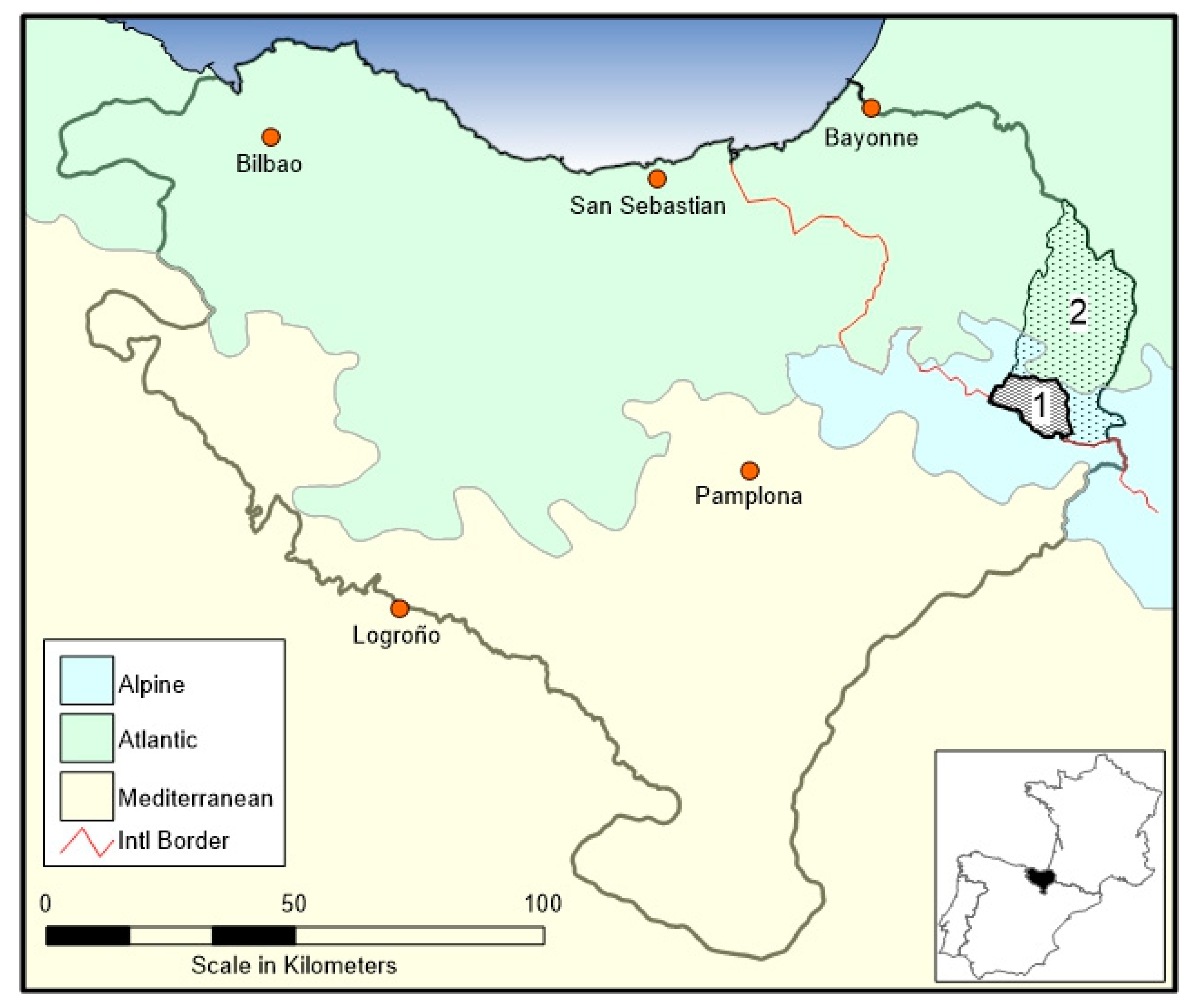
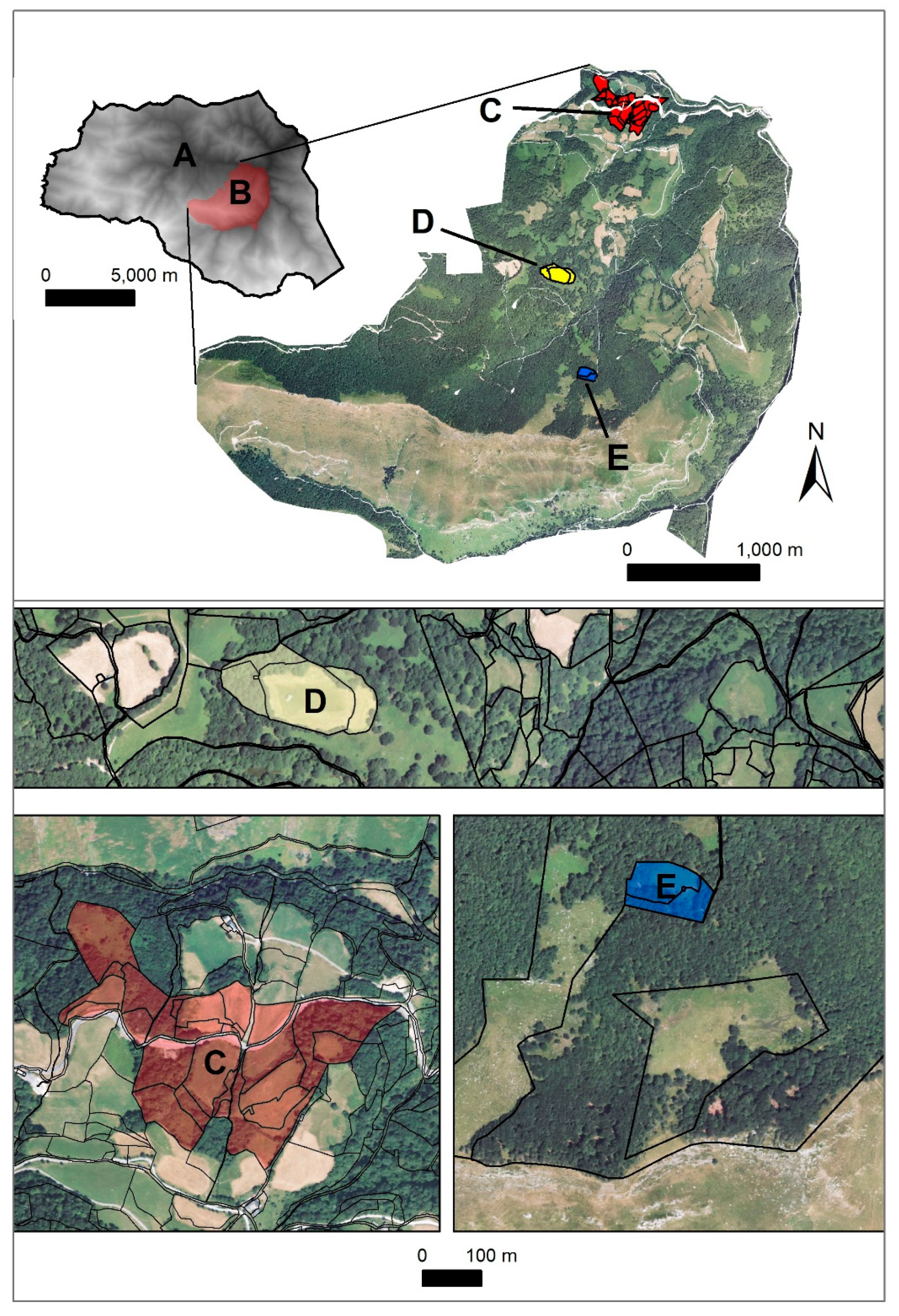
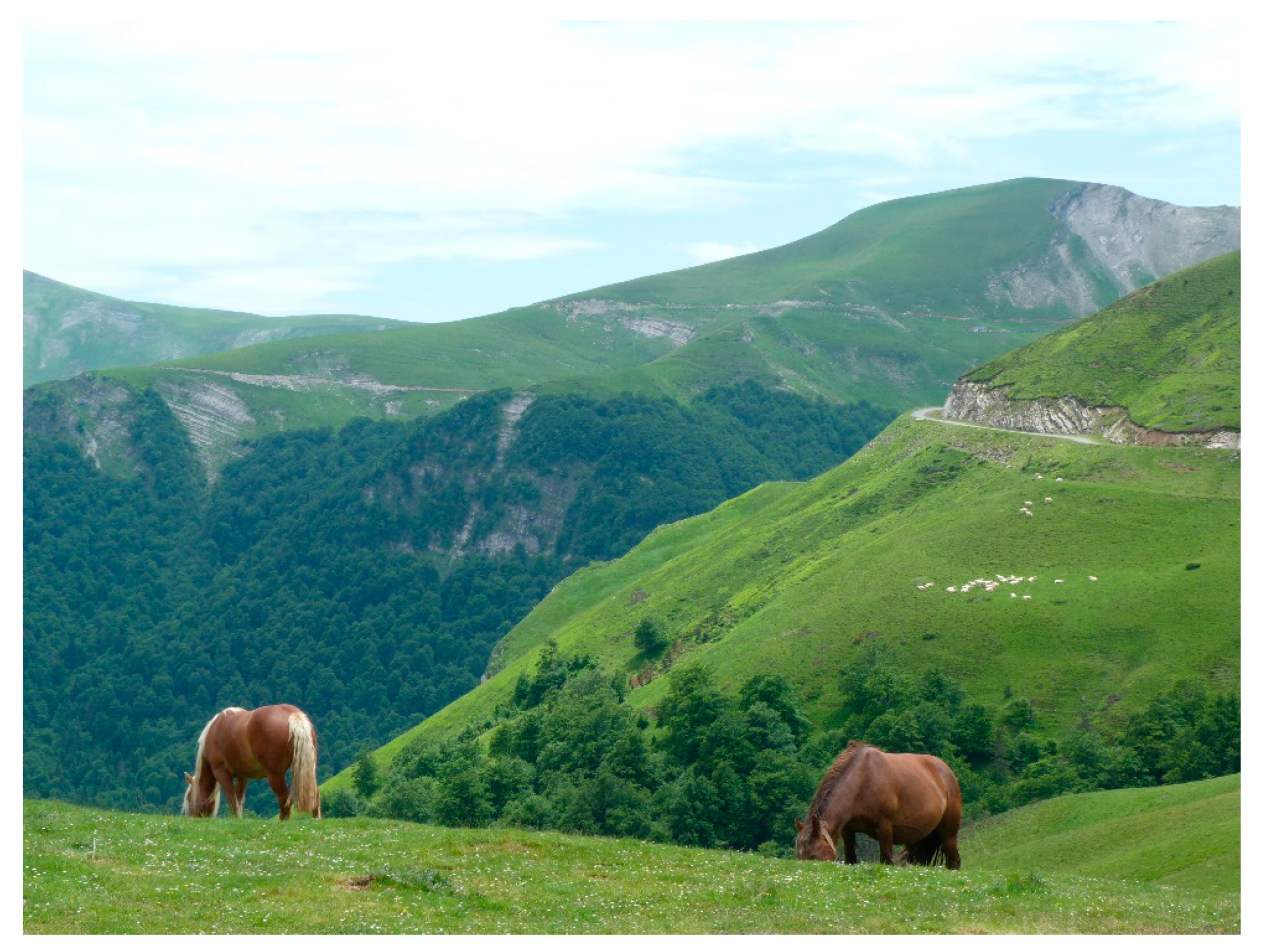
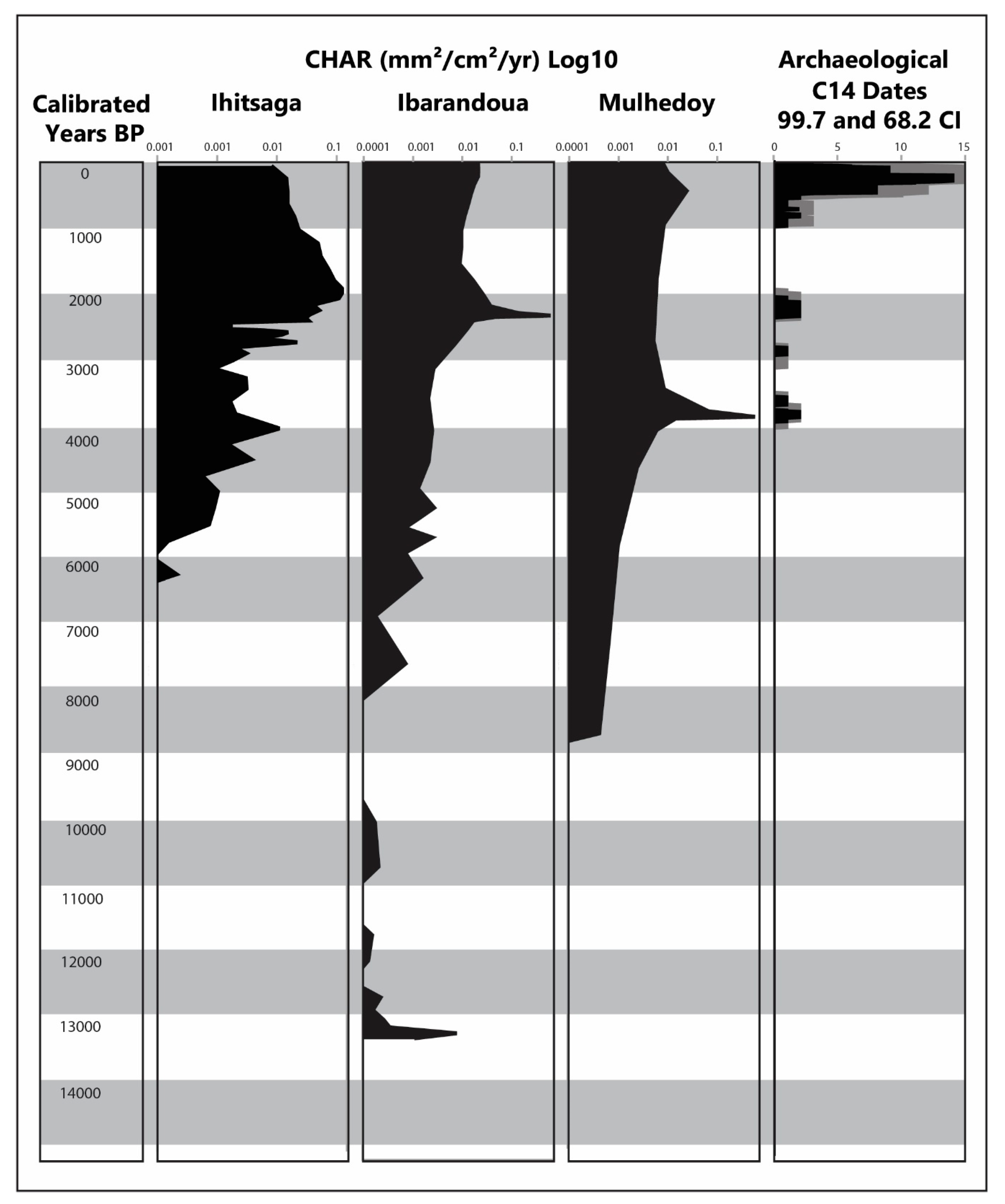
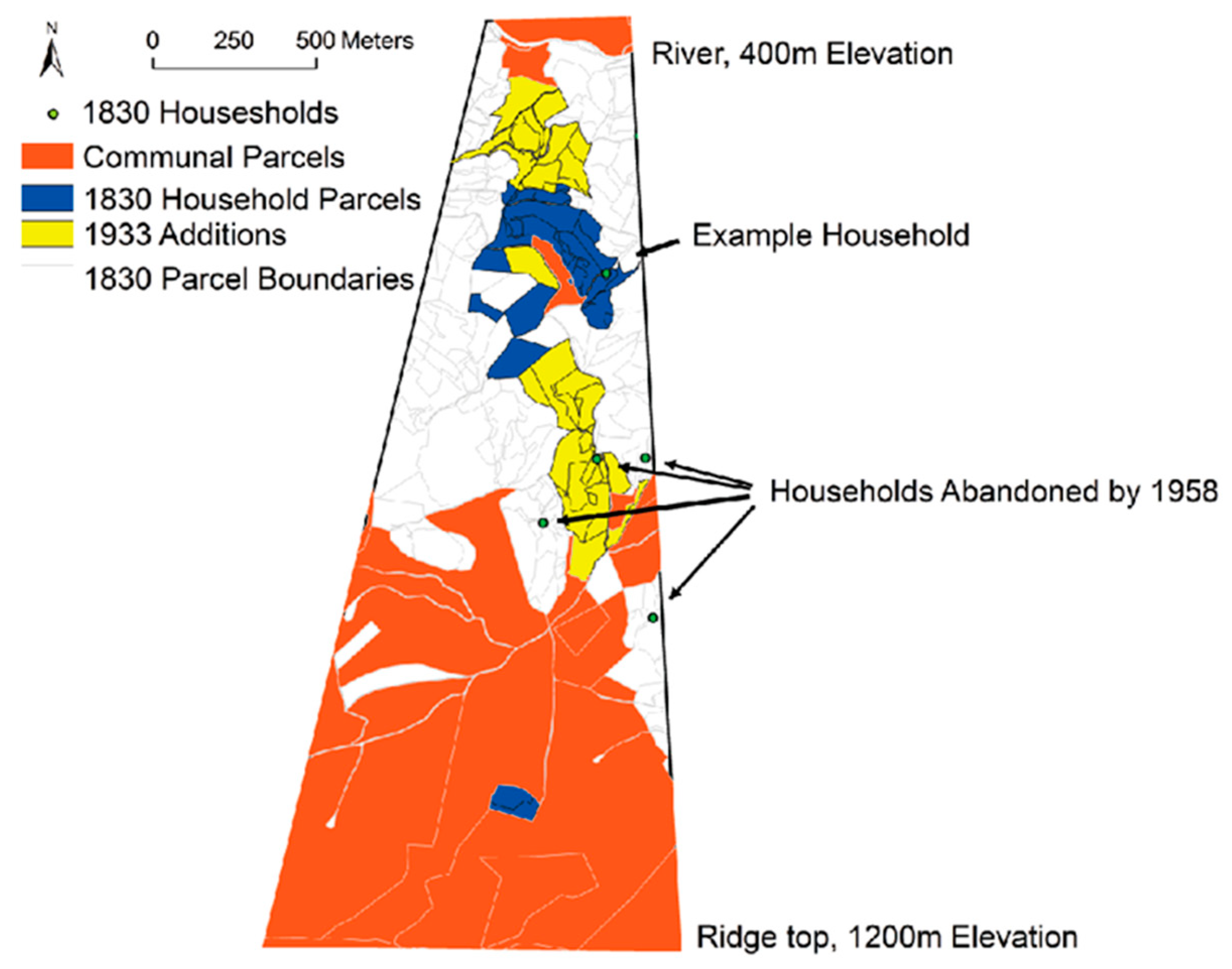
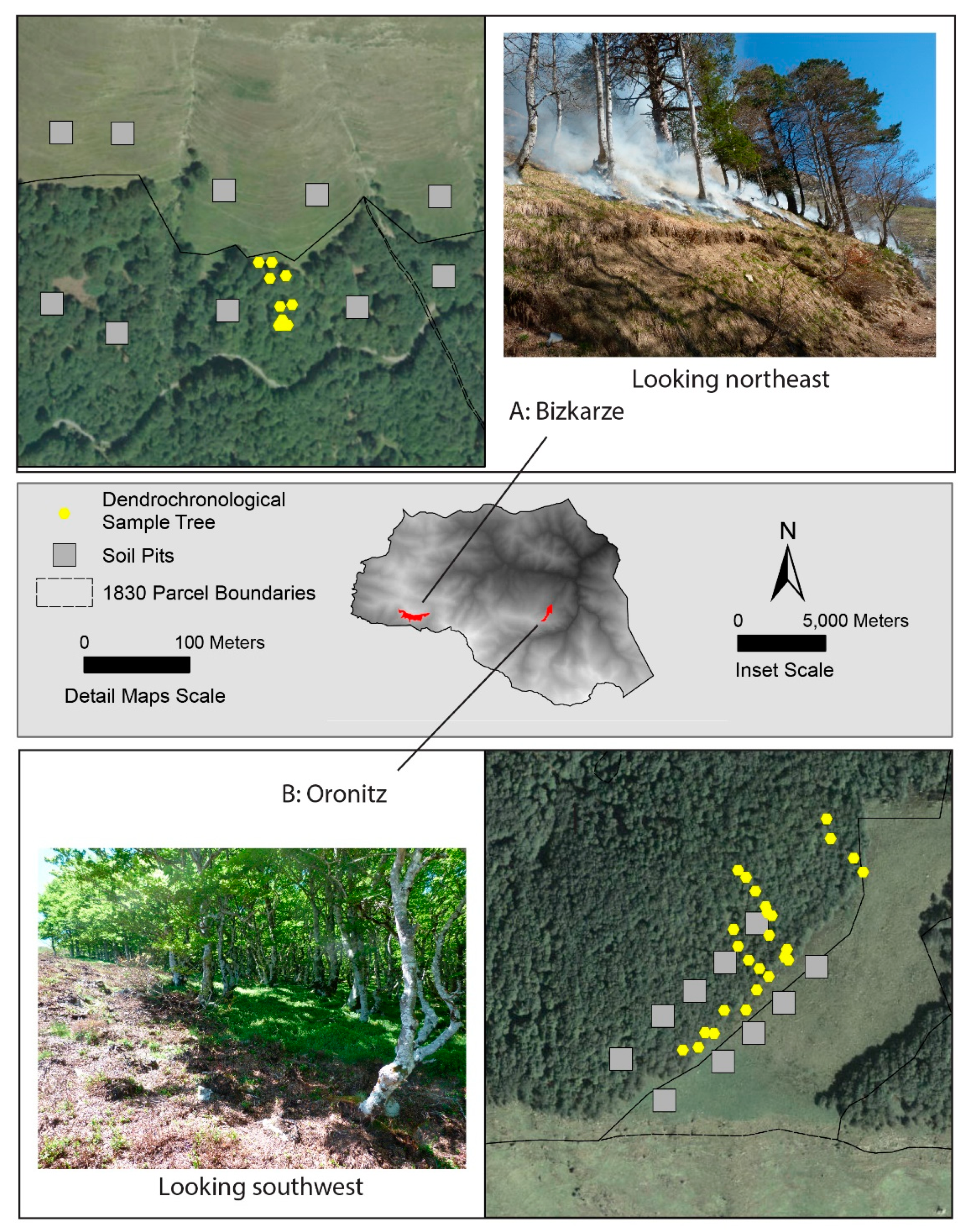
© 2020 by the authors. Licensee MDPI, Basel, Switzerland. This article is an open access article distributed under the terms and conditions of the Creative Commons Attribution (CC BY) license (http://creativecommons.org/licenses/by/4.0/).
Share and Cite
Gragson, T.L.; Coughlan, M.R.; Leigh, D.S. Contingency and Agency in the Mountain Landscapes of the Western Pyrenees: A Place-Based Approach to the Long Anthropocene. Sustainability 2020, 12, 3882. https://doi.org/10.3390/su12093882
Gragson TL, Coughlan MR, Leigh DS. Contingency and Agency in the Mountain Landscapes of the Western Pyrenees: A Place-Based Approach to the Long Anthropocene. Sustainability. 2020; 12(9):3882. https://doi.org/10.3390/su12093882
Chicago/Turabian StyleGragson, Ted L, Michael R. Coughlan, and David S. Leigh. 2020. "Contingency and Agency in the Mountain Landscapes of the Western Pyrenees: A Place-Based Approach to the Long Anthropocene" Sustainability 12, no. 9: 3882. https://doi.org/10.3390/su12093882
APA StyleGragson, T. L., Coughlan, M. R., & Leigh, D. S. (2020). Contingency and Agency in the Mountain Landscapes of the Western Pyrenees: A Place-Based Approach to the Long Anthropocene. Sustainability, 12(9), 3882. https://doi.org/10.3390/su12093882




